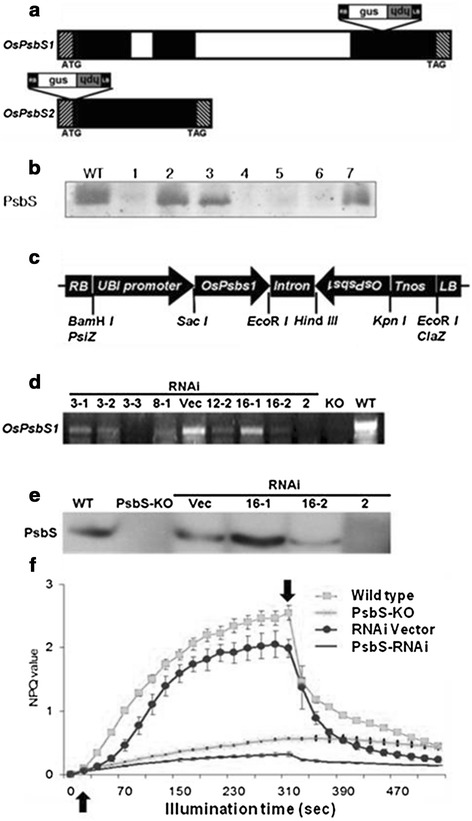Figure 1.

Characterization of PsbS-KO and PsbS-RNAi rice plants. (a) Schematic diagrams of the rice PsbS genes and the T-DNA insertion positions. The exons are shaded and introns are indicated with open boxes. For OsPsbS1, T-DNA was inserted into 3rd exon; for OsPsbS2, T-DNA was inserted into the beginning of the exon. (b) Western blot analysis of putative homozygous and heterozygous plants. PsbS protein was detected with a PsbS-specific polyclonal antibody. Lines 1 to 7 were segregated in the T2 generation of OsPsbS1 plants. (c) Schematic diagram of rice PsbS-RNAi vector. RB, right border; UBI promoter, ubiquitin I promoter; OsPsbS1, inverted repeat of a unique 102-bp fragment of coding region for PsbS gene; Intron, 204-bp portion of the 3rd intron of OsEMF1 gene (AF326768); Tnos, nopaline synthase terminator; LB, left border. (d) Transcript levels for PsbS gene in wild-type, PsbS-KO, PsbS-RNAi, and vector-only rice. Numbers indicate Lines of the PsbS-RNAi transformants. (e) Western blot analysis of PsbS-RNAi transformants and vector-only rice. Wild-type (WT) and PsbS-KO plants were used as positive and negative controls. (f) Light-induced NPQ generation in leaves (intensity of actinic light: 700 μmol photons m−2 s −1). Up arrow, light switched on; down arrow, light switched off. Each point represents mean of at least 4 experiments (SD indicated by bar). NPQ was calculated as described in Methods.
